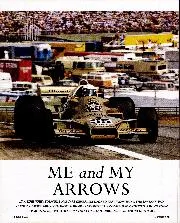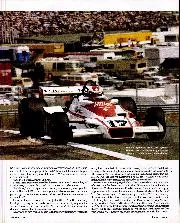Oliver is no longer in the frontline, having ceded control to partner Walkinshaw, but make no mistake — the team is still his baby, and the desire to notch up that first win burns as brightly today as ever.
“The key to the Arrows ups and downs, because we never had enough money to do it properly, is trying to get a combination of two good drivers together, a good talented designer, and a very efficient workforce. The most difficult thing in the business is to make the car, and you need a good little manufacturing base. There is a little bit of luck associated with getting the right engine, designer and drivers together, but you can get pretty close to the front. And we did it four times in 20 years.”

Oliver in 1985: twenty years, no wins but his enthusiasm for F1 remains
Paul-Henri Cahier/Getty Images
The man hired by Colin Chapman to fill Jim Clark‘s shoes, Oliver took part in 49 Grands Prix with Lotus, BRM, McLaren and Shadow, and won Le Mans in 1969. He left F1 at the end of 1973, racing for a while in CanAm and the US F5000 series, before concentrating on running the Shadow team on behalf of colourful American owner Don Nichols. In August 1977 Alan Jones scored an opportunistic debut victory for the team in Austria, but all was not well.
“Alan Rees and I felt Don was not contributing towards the team properly. When we lost UOP and got other sponsorship, things were even tighter. When you have disagreements and you’re not a majority shareholder, you have no other choice but to leave. So I left, and everybody followed us.”
Through November and December Oliver and team manager Rees set up their own organisation. There was talk of buying a secondhand chassis, but when designer Tony Southgate and his assistant Dave Wass joined, work started on a new car. For a while it had no name, until a friend of Oliver’s played with the initials of the team principals, added an extra and created Arrows’.

Oliver & ’68 GP Lotus
Grand Prix Photo
Oliver had commitments from ex-Shadow driver Riccardo Patrese, and Lotus ace Gunnar Nilsson. However, at the time nobody knew quite how ill the latter was, and he dropped out of the project before the 1978 season started. Meanwhile, work progressed at record speed.
“It was a lot easier then to build a car. You could use a Cosworth engine which you could just get off the shelf, and then all you had to do was build a chassis. It was a car ahead of its time. Tony had spent some time at Lotus, so he knew about ground effect. It was a super little chassis, and Riccardo, as his later career would prove, was a fantastic driver. It was a good combination, we didn’t have any engine advantage or disadvantage, so it all came together.”
The new FA1 was rolled out at a snowy Silverstone, where it was announced that the job had taken 54 days from start to finish. The team missed Argentina, but the car was ready for the Brazilian GP, where Patrese qualified 18th and finished 10th, four laps down, after suffering fuel system maladies. Next time out in South Africa the new team caused a sensation. After qualifying seventh Patrese scythed past the cars ahead; he was leading by 14 seconds when his engine blew with just 14 laps to go. Arrows came that close to winning its second ever race…

Patrese and Arrows FA1 launch at a snowy Silverstone in 1978
Hulton Archive/Getty Images
“It was a question of money. The nose had come off in practice, the car had got too hot. We knew that if the engine temperature had gone through the roof we should have changed it, but we took the risk, as we didn’t have another engine to put in the car…”
Suddenly everyone was taking note. In the Swedish Grand Prix at Anderstorp, Patrese finished in second place behind Lauda‘s uncatchable Brabham BT46B fan car, but not before he’d managed to infuriate Ronnie Peterson with his defensive tactics. At Brands Hatch he was again running second, ahead of the eventual winner, Carlos Reutemann, when he picked up a puncture. A first win was surely on the cards in the very near future, but “then we had to build another car, so that put us back.”

Patrese was longest-serving Arrows deriver, completing four seasons. At South Africa in 1978, only the team’s second race, he led until his engine overheated
Grand Prix Photo
You didn’t need to be a copyright expert to realise that the FA1 was almost identical to the latest Shadow DN9, and the new team was taken to court by a bitter Nichols.
“We lost the case. Tony had taken the drawings with him when he stopped working for Don, in the belief that he was an independent consultant and the designs were his. Which was clearly wrong. There weren’t very many of them, and it would have been better if he hadn’t taken them. What we got fined for was the six weeks’ work that he’d put into doing the drawings.”









